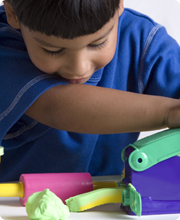Toys and Play: 3- to 5-Year-Olds
You can download this article as a PDF (English, Spanish)
 Children play from the moment they are born. Play is how they learn about themselves and their world. It is how they develop and practice the physical, thinking and social skills needed in life. These tips will help you choose toys and play activities for your child based on their age or stage of development. Think about sharing them with your child’s other caregivers, too.
Children play from the moment they are born. Play is how they learn about themselves and their world. It is how they develop and practice the physical, thinking and social skills needed in life. These tips will help you choose toys and play activities for your child based on their age or stage of development. Think about sharing them with your child’s other caregivers, too.
3- to 5-Year-Olds
- Like to run, jump, climb and balance
- Act out adult jobs with costumes and props
- Begin to share and take turns
- Hate to lose and are not ready for competitive play
- Enjoy simple number and letter activities
- Have more interest in group pretend play
- Like nature, science, time and learning how things work
- Begin to make plans for their play (by about 4 years)
- Can begin to connect pieces in a pattern to make simple models
Toys and Activities
Active
- Push and pull toys, like wagons and strollers
- Toys that mimic adult tools, like a vacuum, shopping cart and small wheelbarrow
- Rocking horse
- Tricycle with helmet
- Jump rope (from 5 years)
- Small bike with training wheels, footbrakes and a helmet (from 5 years)
- Balls
- Lightweight, soft baseball and bat
- Lightweight frisbee
- Sand and water play toys
Puzzles
- Up to 20 pieces (from 3 years)
- 20 to 30 pieces (from 4 years)
- Up to 50 pieces (from 5 years)
Construction
- Large and small wood blocks
- Most types of interlocking building systems with pieces of all sizes (like Lego)
Transportation
- Large-scale trucks that dump and dig
- Car sets and cars of all sizes
- Trains with tracks (non-electric)
Make believe
- Dolls with hair and eyes and limbs that move
- Simple-to-use doll clothes and doll house
- Stuffed animals with accessories and simple clothes
- Puppets and theater
- Dress-up clothes and costumes
- Housekeeping and cooking gear
- Toy phone, camera and cash register
- Doctor kit
- Play sets (garage, farm, airport)
Learning toys and games
- Simple board games based on chance, not strategy
- Dominoes (color or number)
- Picture bingo or matching games
- Simple apps or hand-held games for teaching matching, sorting, shapes, colors, numbers and letters
- Science models (check for age level)
- Magnets, flashlight, magnifying glass, clock, prism and terrarium
- Simple calculator
- Books
- Toys that teach how to button, snap and hook
- Nesting toys
Arts, crafts and musical toys
- Crayons, markers and chalk
- Play-Doh
- Scissors with rounded ends
- Paste, glue or glue stick
- Stickers
- Finger and tempera paint, easel and brushes
- Jumbo lacing beads
- Frames and cards to button, hook and lace
- Simple sewing kit with plastic needles
- Felt board
- Work bench, hammer and nails (with adult supervision)
- Rhythm instruments
- Harmonica, horn, whistles and recorder
Safety
Choose toys that meet these safety guidelines for this age:
- Non-toxic materials
- No sharp points or edges
- Non-breakable
- No parts that could trap fingers, toes or hands
- No electrical parts
- No glass or brittle plastic
- No exposed pins, sharp wires or nails
- Don’t allow children to play with toys that have miniature disk or “button” batteries that can be removed easily
Learn more about toy safety and get tips for choosing toys and play activities for children of other ages.
